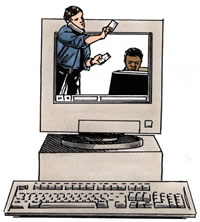|
Vol. 8, No. 4 Fall 2000 |
Subscribe to AT Messenger Download PDF Viewer |
|
PDF Version (for printing) |
Technology to Benefit "Homebound" Students
By Brian J. Hartman, Esq., Project Director, Disabilities Law Program
Recent developments in Delaware hold great promise for "homebound" students. Students unable to attend school for extended periods due to illness or injury have typically been offered instruction at home. School districts generally followed Delaware Department of Education guidelines and provided 5-10 hours of such instruction on a weekly basis. For example, a student recovering from surgery would receive 1-2 hours of individual instruction from a visiting teacher in late afternoon from Monday through Friday. The teacher would check with the student's classroom instructors, offer tutoring following the classroom curriculum, and administer and grade assignments and tests. This approach was adopted for both special education students and those lacking special education eligibility.
In the Spring of 2000, the Department proposed revisions to homebound regulations which provided an exciting opportunity to enhance homebound students' instruction. The Disabilities Law Program (DLP) prompted several amendments, including upgrading the traditional homebound model with technology.
Special Education Regulations
Previous versions of Delaware special education regulations in the late
1970s and early 1980s authorized a home-school telecommunication system
for homebound students. However, it was rarely, if ever, implemented and
the authorization had been deleted from the regulations by the early 1990s.
In the Spring of 2000, the Department completely rewrote its special education
regulations and once again omitted any authorization for use of telecommunication
technology. The DLP, with the support of several councils, advocated for
a regulatory "comment" endorsing a classroom-home telecommunication
system. The DLP noted that advances in technology had made  videoconferencing
commonplace, colleges were successfully offering "live" remote
site access to lectures, and homebound students would benefit from classroom
"hook ups" to their current teachers and classmates.
videoconferencing
commonplace, colleges were successfully offering "live" remote
site access to lectures, and homebound students would benefit from classroom
"hook ups" to their current teachers and classmates.
The Department ultimately agreed and added the following official comment to the regulations:
DOE Note: The IEP team may find that such modern telecommunication technology as videoconferencing allows for medically fragile students or those with contagious diseases to "participate" in classroom activities. -Administrative Manual for Special Education Services (AMSES), Section 6.8.5 (effective July 1, 2000)
Non-Special Education Regulations
At the same time, the Department also issued proposed "homebound" regulations applicable to all students, not only those eligible for special education.1 These regulations had several deficiencies. First, they adopted a "cap" or upper limit on hours of homebound instruction. Second, they authorized no accommodations for students with disabilities eligible for special education under federal laws such as Section 504 and the Americans with Disabilities Act (ADA). Third, they repealed a requirement that the homebound instruction follow the student's curriculum. Fourth, they disallowed homebound for chronic conditions or illnesses. Finally, they repealed an authorization for "a home to school telephone instructional system."
The DLP once again rallied the opposition to the proposed regulations.2 The Department deferred to the DLP's recommendations and completely rewrote the regulations to address all concerns. First, the "cap" or upper limit on homebound hours was deleted. Second, a section was added to clarify a district's duty to accommodate students covered by Section 504 or the ADA. Third, homebound instruction was once again linked to the student's curriculum. Fourth, homebound instruction was authorized for chronic conditions. Finally, an explicit authorization to use technology was added:
Section 3.1. Supportive instruction shall adhere to the extent possible to the student's curriculum and shall make full use of the available technology in order to facilitate the instruction.
The amended regulation was formally adopted by the State Board of Education on July 20, 2000.
The Next Step: A Pilot Project
Although the regulations authorize home-school telecommunication systems, districts may realistically lack the expertise and resources to develop such systems. The DLP is attempting to bridge this gap by promoting a pilot project.3 On July 12, with the endorsement of the Department of Education, the DLP promoted approval of funding by the Delaware Developmental Disabilities Council for a demonstration project. The Council was asked to solicit proposals to research available technology, establish a pilot home-school telecommunication system in conjunction with 1-2 school districts, and assess its effectiveness. Unfortunately, the Council was constrained to defer consideration of all new projects pending a review of available funds. Hopefully, funding will be available through either the Council, a foundation, or alternate source to demonstrate the viability of enhancing the education of homebound students through technology.
Conclusion
In conclusion, recently adopted regulations authorize the use of home-school telecommunication systems for homebound students. With advances in technology, access to such systems should eventually become commonplace. In the meantime, a pilot project is needed to demonstrate the pros and cons of such a model.
Notes
1 The proposed amendments were published at 3 DE Reg. 1338 (April 1, 2000) and republished at 3 DE Reg. 1661 (June 1, 2000). The regulations can be viewed on the Web at www.state.de.us/research/assembly.htm by clicking on the link for "register of regulations."
2 The DLP's analysis was adopted by the State Council for Persons with Disabilities and incorporated in an April 18, 2000 memorandum to the Department. The letter is available on the Web at www.dedisabilityalerts.org/position/homeboundregs.html.
3 The use of telecommunication systems to assist students with disabilities is highlighted in some recent articles. See, e.g., L. Kinross, "Technology Breaks Down Barriers," 30 Exceptional Parent 56 (June, 2000); and V. B. Ira, "Katie's Amazing Videoconferencing System," 30 Exceptional Parent 40 (June, 2000).
Assistive Technology and the IDEA: New Revisions Mean a Greater Role for Technology in IEPs
Technology to Benefit "Homebound" Students
Learning Disabilities and Assistive Technology: How Can AT Help My Child?

